CAUTION: These notebooks are currently (2018-2022) undergoing massive revisions, especially with regard to the various Benton typographical pantographs. I'm posting the updates as I go along, working chronologically. So for now, while some of the later material may still be accurate, don't trust anything after: 1631.
This set of Notebooks started out as a small collection of information in a logical position within the website. Then it just grew. It is now relatively large, still incomplete, and probably in the wrong place.
My own interest in pantographs centers around their use in the from the late 19th century in the making of letterpress printing types, so this Notebook now begins with:
(which includes a fair bit of material on the prehistory of typographical pantographs in the "portrait lathes" and die sinking equipment of the 18th and 19th centuries).
This is followed by a survey of individual pantographs, arranged by kind and then alphabetically within kinds:
For a survey of pantographs as used in the various stages of typographical matrix making, see the pantograph section of the CircuitousRoot boook Making Matrices . This includes a survey chapter on all types of pantographs, to put them in context .
While pantographs date to the 17th century, the origins of the pantograph in typographical use may be traced back to the "portrait lathes" (aka "medallion lathes") and rose engine and die sinking machines from the 18th century. This in turn is part of the larger field which began with rose engine work by the 16th century and is now generally covered by the (not entirely clearly named) field of Ornamental Turning (q.v.).
When pantographs are used for machining/cutting/engraving, they require sharp cutters. There are at least five distinct kinds of cutters: guided single-point engraving cutters (very rare), omnidirectional drag-engraving points, and rotary cutters. (Rotary cutters, in turn, come in several forms: D-bit or single-lip cutters, pyramidal cutters (most common in matrix engraving), and multi-point cutting tools resembling (or identical to) milling cutters.) These cutters in turn require cutter sharpening machines (which were often made by the makers of the pantographs). For information on sharpening machines used for everything except diamond drag-engraving cutters, see the CircuitousRoot Notebook on Cutter Tool Forming and Sharpening.
In addition to these several types of more or less conventional cutting tools, pantographs have been used with other tools as well. Gorton sold a spark erosion unit. Alexander sold a vibrating pen engraver. CNC units today employ a variety of more modern cutting tools, including abrasive waterjets, plasma cutters, and lasers. I don't actually know if any of these were applied to pantographs, but I wouldn't be at all surprised to learn that they were.
At the 2018 Conference of the American Typecasting Fellowship, hosted by M&H Type Foundry in San Francisco, I had the opportunity to present a talk on the subject of the typographical pantograph. Naturally, the full presentation was more than twice as long as the time available. Here it is in two version: First, the abbreviated version that I presented. Then, the full version for those who might care to see all of the details.
Both versions are accompanied by the same two text files containing bibliography and image credits:
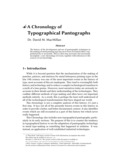

A Chron. of Typo. Pantographs
IMPORTANT: This is a very incomplete rough draft!
One of the peculiar ironies of the history of the pantograph is that while it is set of diverse kinds of machines with a long history and wide application over many fields, within particular fields enthusiasts in that field tend to think of it as unique to it. This Notebook simply attempts to lay out chronologically the history of one field of application: all known pantographs which were employed in, or were part of the history leading to the employment of pantographs in, typographical punch, patrix, and matrix making). This is of course an impossible task even for one field, but a reasonable approximation may be useful.
Presentation Note: This Notebook was created using a derivative of the Knuth TeX digital lettering system and is presented in two PDF files: the Chronology itself and an accompanying Plate Book.
Click here for the digital originals of these two documents and their illustrations.

Barr, for Working Patterns (L&M) [UK]
[NOT DONE] In-house development at Linotype & Machinery, Ltd. (UK) by Mark Barr. 1900. For cutting working patterns for subsequent use in punch engraving. [NOTE: Surviving information is in Legros & Grant and in Barr's GB patents.]
[TO DO: Barr developed half a dozen distinct pantographs (and several other improvements in pantographs, including a microphonic annunciator for detecting engraving tool contact) around the turn of the 20th century. Some of these were 3-D machines which were more closely related to the brocade machines of the engine turners. They did not seem to find application, but are interesting.]
(Mark Barr also filed for two GB patents on his own in 1899, Nos. 8,245 and 8,246 (see also US 651,691 and US 663,153), for the photography of moving objects. In these he described himself as an "Electrical Engineer")
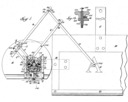
Benton's Four-Bar (Horizontal) Pantographs
These are discussed along with Benton's Single-Arm (Vertical) pantographs, below . For all that Benton's vertical single-arm pantographs have received the most attention, his horizontal, four-bar linkage 1899/1905 "Optomechanical" pantograph may be the cleverest.

Carvit
[NOT DONE; TO DO: Photograph mine] A simple low-relief 3-D pantograph duplicator intended for hobby woodworking. It's an almost forgotten machine, but rather nice for what it is. I was lucky enough to be able to save one from giant rats and dumpsters (yes, the dumpsters were oversize, too).

The Central Type Foundry Pantograph
This would have been a very early application of pantograph engravers to making typefounding matrices. It would appear that this machine was imported from Germany in 1880 by the Cincinnati Type Foundry, but not used successfully there. It was later purchased by Gustave Schroeder and used by him to cut DeVinne for Central.
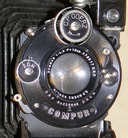
Deckel [DE]
History, classification, and bibliography (but no reprints).
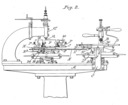
Dedrick [US]
For typographic punch and matrix engraving. Designed by Nicholas Dedrick, at Barnhart Brothers & Spindler. Used there in "1896 or 1897." One sold to Peignot Foundry (France) in 1901.
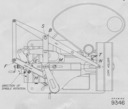
Gorton [US]
Primarily information related to the model P1-2 "Pantomill" 2-dimensional pantograph engraving machine, because that's what I have.
See also the Notebook on the Gorton 375-4 Cutter Grinder, s/n 103-789, at CircuitousRoot

Inland [US]
At some point the Inland Type Foundry (St. Louis, 1895-1912) sold a pantograph engraving machine to Genzsch & Heyse (Hamburg, Germany). The details of this machine are obscure. Nicholas J. Werner mentions it in his "Address" to the St. Louis Club of Printing House Craftsmen .

Kampf [DE]
Maschinenfabrik Michael Kampf KG. Bad Homburg, Germany. A Kampf engraver is illustrated in Southall's Printer's Type in the Twentieth Century , p. 24.
Used by Offizin Parnassia Vättis, e.g. in their recutting of Morris' Troy Type.
Note: Rehak, in Practical Typecasting, p. 100, mentions a "Deckel-Kampf" engraver. I'm not sure that he isn't conflating the Deckel and the Kampf; I can find no indication that there was ever a connection between these two companies.

Leavenworth [US] (Wood Type, From 1834)
In 1834, William Leavenworth, possibly in collaboration with A. R. Gilmore (who is otherwise unknown) developed a pantograph-controlled rotary engraving machine (aka pantograph router) for making wood type. This was the earliest use of such a machine in America. There is a continuous chain of successive businesses from this point to the end of the commercial wood type business with Hamilton. It is presumed that Leavenworth's pantograph was the model for the later models a few of which are documented, but the detailed history of the evolution of the pantograph for wood type making has never been researched (and it is unlikely that sufficient information survives to do so).
Unrelated to the later pantograph engraving machine for wood type of Edwin Allen. I am aware of no evidence that any of the pantograph engraving for wood type, estabalished since the 1830s, had any influence on the various developments of pantographic engraving machinery for the production of metal type in the 1880s.
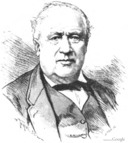
Leschot
Georges-Auguste Leschot (1800-1884), Switzerland (worked in Geneva). Pantograph developed ca. 1839-1844. A horizontal-format four-bar pantograph engraving / light milling machine for the watchmaking firm of Vacheron & Constantin. This was used for the production of uniform watch plates, and had a significant influence upon the industry. (As late as 2013, the firm ran an advertisement in periodicals for the rich, such as Barron's, illustrating this machine.)
At least one of the pantographs of Ferdinand Lotz in the 1870s bears a striking resemblance to Leschot's machine.
It is a notion of mine (for which I cannot yet provide sufficient evidence) that the Leschot pantograph engraving machines probably influenced German pantographs of the mid-19th century and, therefore, (a) the first pantograph matrix engraving done in America, by the Central Type Foundry in 1882, (b) the pantographs of Wiebking, and through him the Ludlow Typograph Company .

Lewis (Keystone Type Foundry) [US]
In the 1903-1906 timeframe, James W. Lewis patented three pantographs. The first two were derivatives of Benton's single-arm machines (and acknowledged as such). The third was a more original design, and its patent (unlike the other two) was assigned to the Keystone Type Foundry. Because of this, I'll group all of Lewis' machines here.

Ludlow Typograph [US]
Together with the Central machine (because it was the first) and the several Benton machines (because they were the best known) this is one of the three most important typographical pantographs ever. Yet it almost unknown; until 2013 there weren't even any published images of it.
See Wiebking-Hardinge / Ludlow, below.

Ogata [JP?]
The late Jim Rimmer used an Ogata RS-260 pantograph engraver (made in 1973) for engraving his matrices. (See Richard Kegler's film, Making Faces, on Rimmer's work. See also Rimmer's book Pie Tree Press. (Kentville, Nova Scotia, CA: Gaspereau Press, 2008): p. 67.)

Preis [US]
H. P. Preis. These (or at least the ones I've seen pictures of) are benchtop machines of the same general scale as the New Hermes. They appear to be more substantial in their construction, though.
Paul Hayden Duensing writes that the Preis "is well-suited to the private [type]founder's needs and is surprisingly accurate." ("Private Typefounding in the U.S.A." in The Printing Art, Vol. 1, No. 2 (Summer 1973): 25), so it has been used for typographical matrix engraving.

Schokmiller [US]
1906. Charles Schokmiller, St. Louis. Possibly used by the Western Type Foundry (of which Schokmiller was a principal at that time). Exported to Stephenson, Blake.
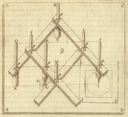
Scheiner (1631)
Christian Scheiner appears to have been the original inventor of the pantograph, in the early 17th century. He first published his work in Pantographice seu Ars Delineandi Res Quaslibet per Parallelogrammum Lineare seu Cavum, Mechanicum, Mobile. Rome: Typographia Ludouici Grignani, 1631.
This book has been digitized many times. Google's digitization of the Bavarian State Library copy is at: https://books.google.com/books?id=Bw5BAAAAcAAJ. The much better digitization by the Getty Research Institute from their copy is online at The Internet Archive at: archive.org/details/gri_33125008065183. The icon above left links to the PDF version of this Getty scan. (The icon itself is taken from that scan.)

Schroeder-Boyer [US]
After 1888. We know of this machine only from a brief comment in one article by N. J. Werner. It was a one-off machine built in St. Louis probably for matrix engraving (but possibly for working pattern engraving; it isn't certain).
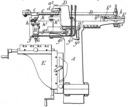
Taylor-Hobson [UK]
The late Jim Rimmer used a Taylor-Hobson pantograph engraver for engraving his working patterns, but not his matrices. (See Richard Kegler's film, Making Faces, on Rimmer's work.)
N.B., the machine is the "Taylor-Hobson." The firm is "Taylor, Taylor & Hobson."

The Varigraph [US]
A template-driven movable pantograph drawing machine. (This is a link up one level, where I consider it in the general chapter on "Typefounding, Lettering, & Printing.")

Wiebking-Hardinge / Ludlow [US]
The pantographic matrix and punch engraving machines developed by Robert Wiebking and Henry Hardinge (along with the successor of these machines at the Ludlow Typograph Company) are among the great lost technological items of history. With these machines Wiebking engraved many of Goudy's early types, and they enabled the success of the Ludlow and 20th century newspaper display advertising. But almost nothing is known about them. They were developed out of a 19th century German pantograph made in Berlin and brought to the US by Herman Wiebking. This machine was developed by his son, Robert Wiebking and Henry H. Hardinge (co-founder of the great Hardinge machine tool company) into one or more very successful machines in the early 1890s. While there were other typographical engraving machines in the 1890s independent of Benton's, Wiebking's were by far the most successful. They were kept secret, however, and not documented.
While what I am calling "single-arm pantographs" are kinematically unrelated to the true pantograph invented by Scheiner these devices came into their own in the 19th century in the fields of die engraving for coining and punch/patrix/matrix engraving for typographical matrix making. Especially in the typographical world they are most often called pantographs, so it is reasonable to expand the term "pantograph" to include them.
The origins of the single-arm pantograph may be traced back first to portrait or medallion copying engines (often the term "lathe" was applied to them, though they didn't really function as regular lathes) which emerged in the late 18th century. These, in turn, were a novel technological solution to the older problem of making portrait medals from larger hand-made patterns. Before the single-arm pantograph was invented, this was accomplished by machines also called portrait or medallion lathes which employed various complicated systems of linkages and, often, chains. For these earlier machines, see the section below on Pantographs by Other Means.

Bergeron (Medallion/Portrait Lathes)
[Nothing here yet; these are more properly treated in Ornamental Turning.]
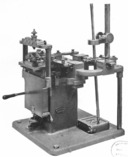
Ballou [US]
Chicago. Late 19th century. Employed for matrix engraving.
The Ballou employs a single (vertical) arm, together with horizontal elements to translate its motion to a cutting tool. These bars look at first like a four-bar linkage, but they are not because two of the four elements are not pivoted but instead are sliders.
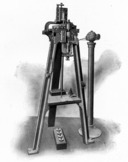
Barr, for Punches (L&M) [UK]
[NOT DONE] In-house development at Linotype & Machinery, Ltd. (UK) by Mark Barr. 1900.
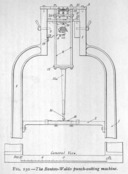
Benton [US]
It is an oversimplification to speak of "the" Benton pantograph. Linn Boyd Benton designed at least five distinct pantographs, some of which were four-bar machines and some of which were single-arm machines. He will be remembered primarily for his vertical-format single-arm pantograph engraving machine for type-making. This was not a single design, however, but a series of machines in at least two major technical revisions developed for three different type-making purposes (patrix engraving, punch engraving, and matrix engraving).
Although they are of widely varying design, I'll collect the Notebooks on all of Benton's pantographs here (whether single-arm or four-bar).

Cronite
A later version of the Engravers' & Printers' Machinery Co. Model C, originally designed by William S. Eaton in 1902. See Eaton and Related (Engle, Glover, Cronite).
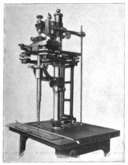
Eaton and Related (Engle, Glover, Cronite)
Machines associated in some way with William S. Eaton. Includes: the Stephen D. Engle single-point cutting tool machine (possibly never manufactured; see also the Francis), the Eaton-Engle drag machine (made by Eaton & Glover), the New Century (patented by Eaton and W. T. Goodnow, made by Eaton & Glover), various Engravers and Printers Machinery Co. (Sag Harbor) machines (including the ones used by Frederic W. Goudy to engrave the matrices for many of his types).

Francis
This machine was unusual in that it employed a single-point cutting tool which was not only moved by the pantograph mechanism but guided in its cutting by the operator (rotary and drag tools, by way of contrast, are omnidirectional). See also the Stephen D. Engle machine.)

Janvier Die Sinking Machines [FR]
The Janvier was a very early 20th century development of the much earlier "medallion lathe." It was a single-arm pantograph in a horizontal orientation adapted particularly for "die sinking" as used in coining.

Lanston Monotype Machine Company [US]
The first machines used by the Lanston company were Benton pantographs on lease. See Patricia Cost, The Bentons.
By the 20th century, they were using machines of their own manufacture. Very little is known about them. One photograph which appears in Wilkes indicates that they were Pierpont machines, or at least very like Pierpont machines.
Charles Henry Beeler, who had earlier developed one or more pantographs of his own concluded his career at the Lanston company. Whether his machine(s) had any influence on theirs is unknown.
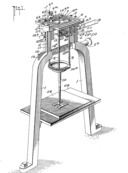
Lewis (Single-Arm Machines) [US]
In the 1903-1906 timeframe, James W. Lewis patented three pantographs. The first two were derivatives of Benton's single-arm machines (and acknowledged as such). The third was a more original design, and its patent (unlike the other two) was assigned to the Keystone Type Foundry. Because of this, I'll group all of Lewis' machines together in the Lewis section of the Four-Bar Linkage Pantographs" group, above.
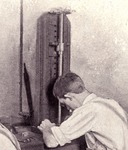
MacKellar, Smiths & Jordan
There is evidence that by 1896 the MacKellar, Smiths and Jordan type foundry used a vertical-format single-arm pantograph which was not one of Benton's.
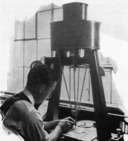
Mergenthaler Linotype [US]
The Mergenthaler Linotype Company leased Benton machines before the amalgamation of Benton's typefoundry into ATF. After that point, their in-house pantograph engraving machine development diverged. In this Notebook, I'll collect information about the post-Benton Mergenthaler machines. Note that Mergenthaler later had a close working relationship with Stempel
This is a "catch-all" category for machines which accomplish the same results as pantographs (copying and scaling) but which employ mechanisms other tha the "four-bar linkage" of the true pantograph or the "single-arm" mechanism also associated with the term. Sometimes these mechanisms have been quite complicated.
Since the emergence in the 19th century of (a) industrial-scale four-bar linkage pantographs as machine tools and (b) the single-arm pantographs associated with Janvier (coining) and Benton (typographical applications), these more complex "pantograph-function" devices do not seem to have been of great importance. However, in the 18th century (and probably the 17th century, though evidence is lacking) "portrait" or medallion copying engines (often termed "lathes") derived from rose engines/lathes solved the problem of creating portrait medals from typically larger hand-carved patterns. These led directly to the development of single-arm pantographs in the late 18th century for use in die sinking for coining. So while these portrait/medallion lathes were not called "pantographs" in their own time and would not generally be recognized as pantographs today, they deserve at least to be mentioned here.

Portrait/Medallion Lathes in the 17th Century
So far I can only discover evidence of these machines through instances of their work which have survived. I have found no information about the machines themselves. That these items were mechanically cut typically is assumed in the literature, but I know of no technical study to confirm this (e.g., one which looks at tooling marks microscopically). Writers tend to assume or assert that such lathes were common, but offer no evidence.
It is interesting to note the negative information here. There is no mention of any portrait or medallion lathe in any of the texts on complex or ornamental turning from this period: nothing in Besson (1578), de Caus (1615), Grollier de Servière, Moxon (1678 N.S. - 1680), or Plumier (1701). There is no mention of any such machine in Woodbury's History of the Lathe to 1850 (1961). Note that de la Condamine's work (1734), which was included in the second edition of Plumier (1749), while often casually claimed to describe portrait or medallion lathes of this kind, is actually (a) a machine-tool simulator along with (b) a generator of profiles from arbitrary curves. Condamine's work is astonishing and is important to the pre-history of computing and CNC machine tools, but it is not relevant here.
Senger (1677). A machine-cut double-medallion preserved in the Museo degli Argenti in the Pitti Palace.
Landgrave Carl of Hesse-Kassel, by 1688.

Medallion Lathe in the Hermitage (1711)
If its the date attributed to it, 1711, is correct then this would be both the oldest surviving portrait/medallion lathe and the earliest of which we have any technical details. It is preserved in the State Hermitage Museum in St. Petersburg, Russia along with slightly later machines by A. K. Nartov. They give its provenance as Italy (Florence), 1711, and call it a "Turning Machine for Copying."
A photograph of this machine is online on the Hermitage website. See the CircuitousRoot Notebook on Ornamental Turning Collections for more information. The image at left is a low-resolution version of this photograph.
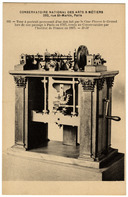
Nartov
Nartov was one of the great outliers of 18th century machine tool building, creating ornamental and medallion lathes of remarkable sophistication in then-distant St. Petersburg, Russia.
The icon at left links to the presentation of material on Nartov in the CircuitousRoot Machine Shop Notebook Nartov. The image itself is of Inventory No. 305 in the Conservetoire national des arts et métiers (CNAM, Paris). It is a "Tour a Portrait" (Portrait Lathe) given by Nartov to France on behalf of Peter the Great. See the CircuitousRoot Notebook on Ornamental Turning Collections for a higher-resolution version.
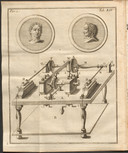
Teubers (1740)
A medallion lathe (or what appears to be one) in Johann Martin Teubers' Vollständiger Unterricht Von Der gemeinen und höheren Dreh-Kunst [Complete Instruction in Common and Higher Turning]. (Regenspurg [the Free Imperial City of Regensburg], 1740.)
The icon at left links to the presentation of Teubers' work in the CircuitousRoot Notebook on the Literature of Ornamental Turning. The image itself is taken from the digitization of Teubers' work in the e-rara digital library of the ETH-Zürich.

Science Museum Inv. 1922-265
This medallion lathe has had a difficult life, both as a physical object and in the historical record. It was discovered derelict in the 20th century and was acquired by the Science Museum (London) in 1922. At that time it was dated to 1760 and attributed to the workshops of Louis XVI, although there is no firm evidence for either. By 1975 it was simply being described as "French" and "Circa 1760" in Science Museum publications. At present (2018) it does not even appear in the online inventory of The Science Museum.
The icon at left links to the presentation of Gentry's 1922 article on this lathe which appeared in The Model Engineer; it remains the most extensive work on it.

Uncertain Instances in 18th Century Coinmaking
The development of the single-arm pantograph is tied up with the history of coinmaking in the 18th century, where earlier machines for making portrait medallions were adapted to the production not only of medals but of dies for coining. This process led to the development of the single-arm pantographic "reducing machine" later associated strongly with the successful machines of Janvier in the 19th and 20th centuries. Unfortunately, histories of coinmaking have tended to conflate the earlier linkage-and-chain medallion lathes with the technologically very different single-arm pantographic reducing engines. Both produced similar products, but they did so by entirely different means. Treating them as a single kind of machine is like claiming that horse-drawn carriages and automobiles are the same because they both carry passengers on roads.
Cooper, in The Art and Craft of Coinmaking, has claimed that "the first pantograph machine nearest in form to the present day reducing machines was made by Dollond in 1743." No details about this machine are available, and while the Dollonds did make pantographs, they had not yet entered professionally into the instrument making business by 1743.
It is possible that Jean Baptiste Dupeyrat was manufacturing (and exporting from France) single-arm pantographic "reducing machines" for coining from around 1780 to the 1790s. It is equally possible, based on the evidence now known, that he was not and that his reducing machines were based on earlier technologies of medallion lathes employing systems of linkages and/or chains.
There are a few pantographs that we know with certainty existed but for which we don't even have enough technical information to know whether they were four-bar, single-arm, or some other type.

Edwin Allen [US] (Wood Type, From 1836)
An independent re-invention of the pantograph engraving machine as applied to the manufacture of wood type. I know of no technical details of this machine, the kind of pantograph it was, or its appearance.
Unrelated to the earlier pantograph engraving machine for wood type of William Leavenworth. I am aware of no evidence that any of the pantograph engraving for wood type, estabalished since the 1830s, had any influence on the various developments of pantographic engraving machinery for the production of metal type in the 1880s.

Beeler (Metal Type)
Charles H. Beeler. By 1899. For changing the proportions of metal type during manufacture; possibly a later machine for automatically generating back-slope and italic letterforms from roman patterns. It is not known if this machine was used commercially, or if so by whom. If it was, the MacKellar, Smiths and Jordan type foundry would be the most likely candidate.
Beeler concluded his career at the Lanston Monotype Machine Company. Whether there was any connection between him and the development of the pantograph engraving equipment they used after they progressed from leased Benton machines is not known.

Legros & Colebrook's Bicycle-Tube Machine
A one-off machine by Lucien A. Legros, probably for working pattern making in conjunction with the high-speed Wicks Rotary Typecaster. See Pantographs for Working Patterns chapter of Making Matrices
This seems like a strange category, but the historical literature on pantographs is not always clear.

Gem [CH?]
Swiss. Rehak mentions this machine in Practical Typecasting, p. 100. I have been able to discover nothing further about any such machine.

Little Pioneer [?]
This machine may be a "ghost"; I'm not sure if it really existed. The only reference I have been able to find for it is a citation by Theo Rehak in his Practical Typecasting, p. 100, where he observes that it was used by Goudy. Now, for his Working Pattern engraving, Goudy used a (1) a Deckel machine prior to the 1939 destruction of his workshop by fire, (2) his matrix engraving machine, briefly, from ca. 1939 to 1943 when he was able to obtain another industrial pantograph, and (3) a industrial pantograph, type yet unknown, from Sept. 1943 on. For his matrix engraving, Goudy consistently used one of three machines manufactured by the Engravers' and Printers' Machinery Co. of Sag Harbor, NY (closely resembling their Model D). So if a "Little Pioneer" exists, it could only be either Goudy's 1943 Working Pattern engraving machine or a model (not manufacturer) name for his matrix engraving machine. As of 2012, Google knows absolutely nothing about a "Little Pioneer" machine (other than its indexing of Rehak's book).
It is no doubt presumptuous to say that certain machines which are in fact traditionally called pantographs are "not really pantographs," especially when I'm classifying a number of machines as pantographs which often are not called pantographs. Yet at least one machine (the overhead apparatus on electrical streetcars and trains) is known as a "pantograph" yet performs none of the scaling function associated with all other kinds of pantographs. It's called a "pantograph" because it looks a bit like one, not because it acts like one. It certainly isn't wrong to call it a pantograph (especially when trying to communicate with streetcar enthusiasts who know it by that name), but it is useful to understand what it is and is not doing.
Here is such a "pantograph" shown on an electric train of the Swiss Schynige Platte Railway.
(Photograph taken in 2007 by Audrius Meskauska and uploaded to Wikimedia Commons. Source: http://commons.wikimedia.org/wiki/File:Schynige_Platte_diamond_pantograph.jpg )
Attachments or auxiliary devices, primarily for pantograph engravers, which were not made by the manufacturers of the machines themselves.
A pantograph works by copying an original. Generally, originals were made either by the user of the pantograph or by its manufacturer (especially when these patterns were "copy types" and the pantograph was used for engraving lettering).

Artco
As of the catalog "Master Copy Type" (Monrovia, CA: Artco Engraving Machine Accessories, 2009) this company sold "copy type" for pantographs. I can no longer find this information on their website, however. ( http://www.artcotools.com/ )
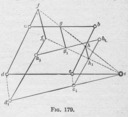
On Pantographs
General works on pantographs, without extensive reference in them to pantograph engraving. [At present just a chapter from a 1915 volume on mechanism.]
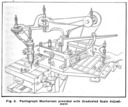
On Engraving (with Pantographs)
General works on machine engraving which have useful bits about pantograph engraving.
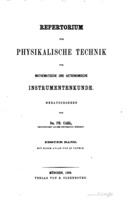
Fischer. (1866)
Fischer, Ernst. "Ueber Pantographen" In Carl, Dr. PH. ed. Repertorium für Physikalische Technik für Mathematische und Astronomische Instrumentenkunde. Vol. 1 ["Erster Band"] (München, Königsreich Bayern [Munich, Kingdom of Bavaria]: R. Oldenbourg, 1866).
and
Carl, Dr. PH., ed. Repertorium für Physikalische Technik für Mathematische und Astronomische Instrumentenkunde. Vol. 1 ["Erster Band"] Atlas [of plates, 1 through 37] (München, Königsreich Bayern [Munich, Kingdom of Bavaria]: R. Oldenbourg, 1866).
In German. This is a brief history of the pantograph which describes several German, French and Swiss machines not widely known in America (Mailäander, Friedrich Holler (Nürnberg), Breithaupt (Cassel), Ertl & Sohn (München), Adrien Gavard (Paris), J. Goldschmidt (Zürich)).
This has been digitized at least five times, but none of these digitizations contain useful plates (two omit the "Atlas" volume of plates entirely, while three do not fold the plates out in).
Digitized by Google from the University of Ghent copy. This copy lacks the plates as originally bound. Here's an extract of Fischer's article: repertorium-fur-experimental-physik-vol-1-1866-google-ghent-pp257-276-pdf273-292-fischer-ueber-pantographen-NO-PLATES.pdf
Digitized by Google from the Harvard University copy. As bound in the 19th century, this copy is missing not only its plates but also its title page and most of its front matter. (This is not the worst I've seen from this source; the bindery employed by Harvard in the 19th century was criminally incompetent.) Here's an extract of Fischer's article: repertorium-fur-experimental-physik-vol-1-1866-google-harvard-pp257-276-pdf263-282-fischer-ueber-pantographen-NO-PLATES.pdf
Digitized by Google from the University of Michigan copy. Nominally this includes the "Atlas" volume of plates, but the plates were not folded out so as to be visible when photographed, and none of the plates in question are actually present in this digitization. Here is an extract of Fischer's article together with the title page and contents page of the "Atlas" of (now blank) plates: repertorium-fur-experimental-physik-vol-1-1866-google-mich-pp257-276-pdf267-286-fischer-ueber-pantographen-PLATES-SCANNED-AS-BLANK.pdf
Digitized by Google from the Oxford University copy. Nominally this includes the "Atlas" volume of plates, but the plates were not folded out so as to be visible when photographed. By chance, a few fragments of them are visible. Here is an extract of Fischer's article together with the title page and contents page of the "Atlas" of (now lost) plates, with fragments. repertorium-fur-experimental-physik-vol-1-1866-google-oxford-pp257-276-pdf269-288-fischer-ueber-pantographen-PLATES-FRAMENTS-ONLY.pdf The icon above left links to this extract, as it is, alas, the most complete available.
Also digitized by Google from the U. Penn. copy and available via The Hathi Trust. This digitization nominally includes the "Atlas," but, again, the plates were not folded out and are useless.
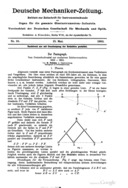
Pellehn. "Der Pantograph." (1903)
Pellehn, G. "Der Pantograph." Deutsche Mechaniker-Zeitung. Jahrgang 1903, in No. 10 (15 May): 85-90, No. 11 (1 June): 93-95, No. 12 (15 June): 105-107, No. 13 (1 July): 113-117), and No. 14 (15 July): 14-125-129. In German. This gives a brief history of the pantograph and lists a number of 19th century German pantographs not commonly encountered in the anglophone literature.
This has been digitized twice by Google, but both digital versions have issues.
One is a digitization of the University of Chicago copy. This is available as a PDF; the icon above left links to an extract from that PDF of just the five issues which contain Pellehn's article. It is a Google Books digitization of normal (that is, poor but workable) quality. The confusing thing about it is the (a) the University of Chicago bound their original together with Zeitschrift für Instrumentenkunde and then (b) cataloged the combined volume as Vol. 23 of " Messtechnik" (under which title Google lists it). Also, as was so often the case in the 19th century, the original binder wanted to pretend that this was a book rather than a journal, and so discarded not only the advertising pages for each number but also the introductory pages which contain the actual masthead for each number.
The other digitization is from the Stanford University copy. It is, confusingly, filed by Stanford under Zeitschrift der Deutschen Gesellschaft für Mechanik und Optic, but at least it includes all of the pages for each number. The real problem is a bug in Google Books which will not permit the direct download of a PDF of this public domain book. I was able to assemble a copy via the pysheng utility, but the image quality of the on-screen pages that it gets is even worse than the PDF version. But it does put the series of articles in the full context of the issues of the journal. Here is an extract of the five issues: deutsche-mechaniker-zeitung-google-stanford-1903-nos-10-14-pellehn-pantograph.pdf

Graduating, Engraving and Etching. (1921)
Graduating, Engraving and Etching. NY: The Industrial Press, 1921. [TO DO: Process Hathi images to PDF and add here]

Huff. "R & I Industry Scrapbook." (2003-2004)
In 2003-2004, Kristin Huff wrote a series of six articles under the general title "R & I Industry Scrapbook" for The Engravers Journal [sic, no apostrophe] ("R & I" is the Recognition and Identification industry). Huff's emphasis is on the development of engraving machinery for the jewelry trades, rather than on heavier industrial engraving and industrial pantograph use (let alone the rather specialized field of typographical punch, patrix, or matrix engraving). Still, this is a good overview of the field. Part 2 has some interesting history of 19th and early 20th century pantographic engraving machines such as the Francis and some Eaton-Glover machines. (The unidentified "mystery engraving machine" shown in the color photograph at the end of Part 2 is an Eaton-Engle Engraving Machine manufactured by The Eaton-Glover Co., NY.) The subsequent parts focus on later computerized and laser engraving equipment.
Huff's articles are in copyright, so I cannot reprint them here. They are available online, though, at the Engravers Journal website:
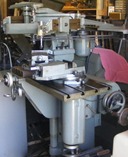
Deckel GK-21, s/n 6,703
This is a link to the Notebook on the Deckel GK 21 Pantograph Engraving and Profiling Miller, s/n 6,703, at CircuitousRoot Notebook in the ../../ Machine Shop set of Notebooks.

Gorton P1-2, s/n 41,693
This is a link to the Notebook on the Gorton P1-2 "Pantomill," s/n 41,693, at CircuitousRoot Notebook in the ../../ Machine Shop set of Notebooks.
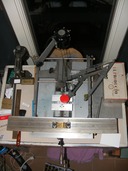
New Hermes Engravograph IL-K, s/n 24,913
A "pivoting" rotary-spindle machine.
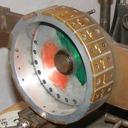
New Hermes Locomotive Engraver, s/n 60,733
Yes, really. Well, sort of. It is a machine which came out of the EMD locomotive plant in Illinois. It was used to engrave serial numbers on locomotive parts. It bears no model designation, but is probably a modified model ITX. It has been modified for serial number engraving in a very interesting way.
Scheiner's 1631 Pantographice seu Ars Delineandi is in the public domain, and remains so in its digitizations by Google and Getty and their reproduction here.
The photograph of a 1711 medallion lathe in the State Hermitage Museum is copyright by them and is used noncommercially here for scholarly purposes pursuant to their licensing terms. Please note that any re-use of it must be under the original licensing terms imposed by the State Hermitage Museum.
The photograph of a railway "pantograph" on the Schynige Platte Railway, taken by Audrius Meskauska, is copyright by him and is licensed by him under the Creative Commons Attribution-ShareAlike 3.0 Unported license.
All portions of this document not noted otherwise are Copyright © 2011-2013, 2018-2022 by David M. MacMillan.
Circuitous Root is a Registered Trademark of David M. MacMillan.
This work is licensed under the Creative Commons "Attribution - ShareAlike" license, version 4.0 International. See http://creativecommons.org/licenses/by-sa/4.0/ for its terms.
Presented originally by Circuitous Root®